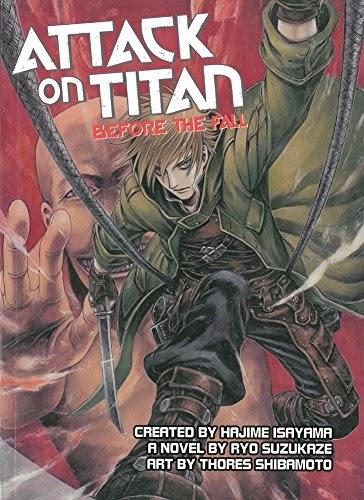 Title: Attack on Titan: Before The Fall
Title: Attack on Titan: Before The Fall
Genre: Fantasy
Publisher: Kodansha (JP), Vertical (US)
Original Creator: Hajime Isayama
Writer/Artist: Ryo Suzukaze, Thores Shibamoto
Translation: Ko Ransom
Original Release Date: September 16, 2014
If you’re already knee deep into the world of Hajime Isayama’s Attack on Titan series, then you owe it to yourself to pick up the light novel version that Ryo Suzukaze penned and has now been translated into English. If you’re not a fan of the manga series, or basically can’t stand some of the more droll moments, the yelling, or the artwork, you should still consider picking up this story before that one — where the titans are considered immortal, the weaponry to defeat them doesn’t exist, and, of course, Eren and that crew don’t make a single appearance in this novel! But in all seriousness, Before The Fall is an excellent example of using material that you still have to conform to certain tendencies, but you can enhance them to create a stronger experience than you’d least expect.
Set 70 to 72 years from the start of the main series, Before The Fall paints a picture where there literally is no hope: the titans appeared with no known reason why or how, they killed off practically all of humanity, and with no weapons or understanding of how to defeat them, the people created walls to hide themselves in, and that’s how it’s been ever since. The people have then lived in relative peace for over 30 years, but with the understanding that they live in a cage, and that they have to accept their fate. With failing Survey Corps missions and no victories to speak of, it doesn’t look like that’s going to change, until a brutal incident not only affects the future of the Survey Corps, but of one man determined to prove titans can be killed.
That one man is an craftsman who can’t really fight.
The obvious difference between placing the fate of humanity in the hands of Eren, a young kid obsessed with killing titans, and Angel, also a young man who can’t fight but can sure craft, is a very interesting contrast. Angel managed to showcase his talents at a young age and worked his way up to develop some weapons for the Survey Corps in order to defeat the titans. With the perspective of following a character who isn’t actually fighting though, it allows us to follow someone who isn’t connected (though he slowly does get involved to an extent in battle) with the fight for humanity, while also seeing some of the processes for coming up with a way to defeat a titan. As said earlier, this is set in a world where everyone believes the titans are immortal, so even just seeing stuff like Iceburst Stone and Iron Bamboo is an interesting explanation on how we eventually get the blades that do kill titans, and the vertical maneuvering gear that allows the soldiers the ability to kill titans.
It also showcases more or less the human politics at play, where nobody really likes the Survey Corps wasting money and lives to defeat immortal beings. Unlike in the main series, where it’s more obvious that the politics in play are rooted in darkness and a case of hiding the truth, it’s more justifiable here, with no victory to speak of or anything to hang their heads on. That’s why it makes the drama that takes place in this light novel compelling and a fun page turner. It’s also fascinating, as someone that has been reading the manga, to read this knowing of course, all of this is a setup for what takes place in the main series. The people in this series won’t be around (at least, I think it’d be improbable!) when Shinganshina falls. We know that humanity doesn’t achieve its first victory against the titans until they retake Trost. With this knowledge of future events, it actually makes everything that takes place interesting, and a good setup for how certain things are seen in the main series.
I don’t believe this leaves those who haven’t read the manga out of the cold though. With its setup more akin to an origin story and more or less nowhere near set to the main series, this allows newer people to take in what undoubtedly is more horror story and more of how humanity deals with something that’s still new to them with no weapons created to beat them. While the book is somewhat lengthy, (especially when they try to explain certain materials) the information comes quick and you can probably finish this in a week or two.
The only few issues I have with the novel are that, again, the material explanation, while needed, I felt wasn’t all too enjoyable a read. The characters, aside from a few, don’t stand out too much even with some details explained. It then gets a bit too predictable, especially towards the end, though I will admit one of the predictable events involved a very strong character. But otherwise, this is a great read. No matter where you stand on Attack on Titan, this is a work worth checking out.

